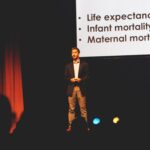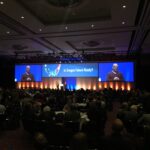 About 160 business leaders and Oregon State University students and faculty members gathered in Portland to hear about the role of innovation in business from prominent CEOs representing the core industries of Oregon.
About 160 business leaders and Oregon State University students and faculty members gathered in Portland to hear about the role of innovation in business from prominent CEOs representing the core industries of Oregon.
By Emma Hall
About 160 business leaders and Oregon State University students and faculty members gathered at the Governor Hotel over Cobb salads to hear about the role of innovation in business.
Patricia Bedient, Executive Vice President and CEO of Weyerhaeuser, gave the keynote address. She described how her 110-year-old company used innovation in everything from new imaging technology to polymers in order to stay on top of the industry.
Weyerhaeuser uses LIDAR, a technology that uses light to map out trees on a terrain from above, in order to gain insight on their trees. The company is also coming up with new uses for the cellulose fibers they develop and manufacture, such as using them for biomass in the future. In 2008, Weyerhaeuser began a joint venture with Chevron to develop biomass fuels from their forests, called Catchlight Energy LLC.
Bedient answered audience questions on topics ranging from manufacturing overseas to government support of higher education. She also explained that in order to foster innovation, one must be open to failure. “One of the most important things about innovation is rewarding failures, as long as we learn from them,” Bedient said “It’s as much about rewarding risk-taking as it is about rewarding success.”
After Bedient’s talk, a panel of five CEOs and business experts discussed the role of innovation in business, and how it relates to the hot button topic of creating jobs and growing new markets. Moderated by Steve Clark, president of the Portland Tribune and Community Newspapers, the panel members included Bill Chambers, Ryan Deckert, Larry Mullins, Jim Piro, and Ananthan Thandri.
“To me, there’s opportunity for innovation everywhere you look,” Stahlbush Island Farms President and CEO Bill Chambers said. The fourth-generation Oregonian explained that one place Stahlbush Island Farms found opportunity for innovation was the unlikeliest of places — the waste bin. The realization that energy and agriculture are closely linked led Stahlbush to create a Biogas Plant, which can create enough electricity for about 1,100 homes out of fruit and vegetable waste.
Stahlbush Island Farms also released the first biodegradable bag for frozen fruits and vegetables.
Other innovations that Chambers’ company uses are technology-based, such as GPS-guided tractors and robotic irrigators. The tractors work independent of human operators, allowing for more efficient farming that can go on 24 hours a day. The robotic irrigators can be programed for two-week periods, and even are equipped with a cell phone so they can call for help if they run into a problem.
Oregon Business Association President Ryan Deckert was the second panel member to speak on innovation. “The last great hope for America is creativity and the American mind,” he said. He talked about the Oregon Innovation Council (Oregon InC) and how it was working to support research and startups in Oregon through its various programs, including ONAMI, OTRADI, OWET and Oregon BEST.
Deckert agreed with keynote speaker Patricia Bedient’s point that a part of encouraging innovation is being open to failure. He described an OWET buoy launch, with a gathered crowd, balloons and decorations, only to have the buoy sink. “It’s almost Caddyshack-esque,” he laughed.
Samaritan Health Services President and CEO Larry Mullins talked about innovation in the health-care industry. “I always describe our field as innovation by mandate,” Mullins said.
He explained the wide meaning of innovation, which doesn’t just refer to technology. Innovation could mean changing something in order to create more jobs, for example. “We have to look at economic innovations as much as clinical innovations,” Mullins said.
Portland General Electric President and CEO Jim Piro spoke about innovation for the 120-year-old utility. One of the company’s recent innovations is a “smart meter,” with a computer chip. The meter can provide real-time information on a home or business’s electricity usage. In the future, this will allow the company to know about a power outage before a homeowner even does, and work towards fixing the problem. For now, the real-time information has been useful to crack down on those stealing the company’s products-often the same people who are growing illegal crops, Piro said.
The last panel member to speak on innovation in his sector was Mentor Graphics Vice President and CIO Ananthan Thandri. Thandri reiterated the point that innovation isn’t necessarily about new products or technology, even in a technology field such as his. Innovation can mean using an old idea in a new way. As an example he compared the old habit of timesharing (renting a computer and storing all your information on a floppy disc) to the current buzzword in the industry: cloud computing.
The five-panel members answered audience questions after they were done speaking on innovation in their sectors. The industries represented at the CEO summit were quintessentially Oregon: health, energy, technology and agriculture. All four made it clear that innovation was necessary to grow business in Oregon. “If you’re a company that’s not innovating, then you’ll fall behind,” said Piro.
Emma Hall is web editor for Oregon Business.





